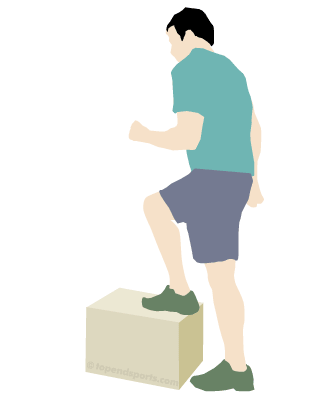The Queens College Step test is one of many variations of step test procedures, used to determine aerobic fitness. Compared to the Harvard Step Test, this version has a lower step height, slower cadence, shorter test duration and more simple analysis. A similar test is the YMCA 3-minute step test. See the other variations of step tests.
purpose: this sub-maximal test provides a measure of cardiorespiratory or endurance fitness (see also other step tests)
equipment required: 16.25 inches / 41.3 cm step, stopwatch, metronome or cadence tape, heart rate monitor (optional).
pre-test: Explain the test procedures to the subject. Perform screening of health risks and obtain informed consent. Prepare forms and record basic information such as age, height, body weight, gender, test conditions. Check step height and set metronome. See more details of pre-test procedures.
 procedure: The athlete steps up and down on the platform
at a rate of 22 steps per minute for females and at 24 steps
per minute for males. The participants are to step using a four-step cadence, 'up-up-down-down' for 3 minutes. The athlete
stops immediately on completion of the test, and the heart beats
are counted for 15 seconds from 5-20 seconds of recovery. Multiply this 15 second reading by 4 will give the beats per minute (bpm) value to be used in the calculation below. See video of this test being performed.
procedure: The athlete steps up and down on the platform
at a rate of 22 steps per minute for females and at 24 steps
per minute for males. The participants are to step using a four-step cadence, 'up-up-down-down' for 3 minutes. The athlete
stops immediately on completion of the test, and the heart beats
are counted for 15 seconds from 5-20 seconds of recovery. Multiply this 15 second reading by 4 will give the beats per minute (bpm) value to be used in the calculation below. See video of this test being performed.
scoring: an estimation of VO2max can be calculated from the test results, using this formula (McArdle et al.,1972). A rating can be determined using the VO2max norms.
men: VO2max(ml/kg/min) = 111.33 - (0.42 x heart rate (bpm) )
women: VO2max(ml/kg/min) = 65.81 - (0.1847 x heart rate (bpm) )
variations: if you wish to use a heart rate monitor to measure heart rate, take the heart rate reading at the 20 seconds mark post-exercise.
reliability: test re-test reliability for recovery heart rate has been measured as r = 0.92
validity: correlation between recovery heart rate and VO2max has been measured as r = -0.75.
advantages: minimal equipment and costs involved, little time required, and can be self-administered.
disadvantages: Biomechanical characteristics vary between individuals (e.g. taller people are at an advantage). Also, apparently the data was formulated from treadmill running, therefore their assumption is that stepping and treadmill running have the same oxygen cost.
reference: W.D. McArdle et al. (1972) Reliability and interrelationships between maximal oxygen uptake, physical work capacity and step test scores in college women. Medicine and Science in Sports, Vol 4, p182-186.
Similar Tests
- General Step Test procedure, which has links to many other step tests.
- There is a similar YMCA 3-minute step test.
Related Pages
- About a Queen's College Step Test iphone app
- See a video of Queens College Step test plus other videos of Step tests being performed.
- Step up exercises at the beach or during pregnancy.
- More information on measuring heart rate.


 Current Events
Current Events